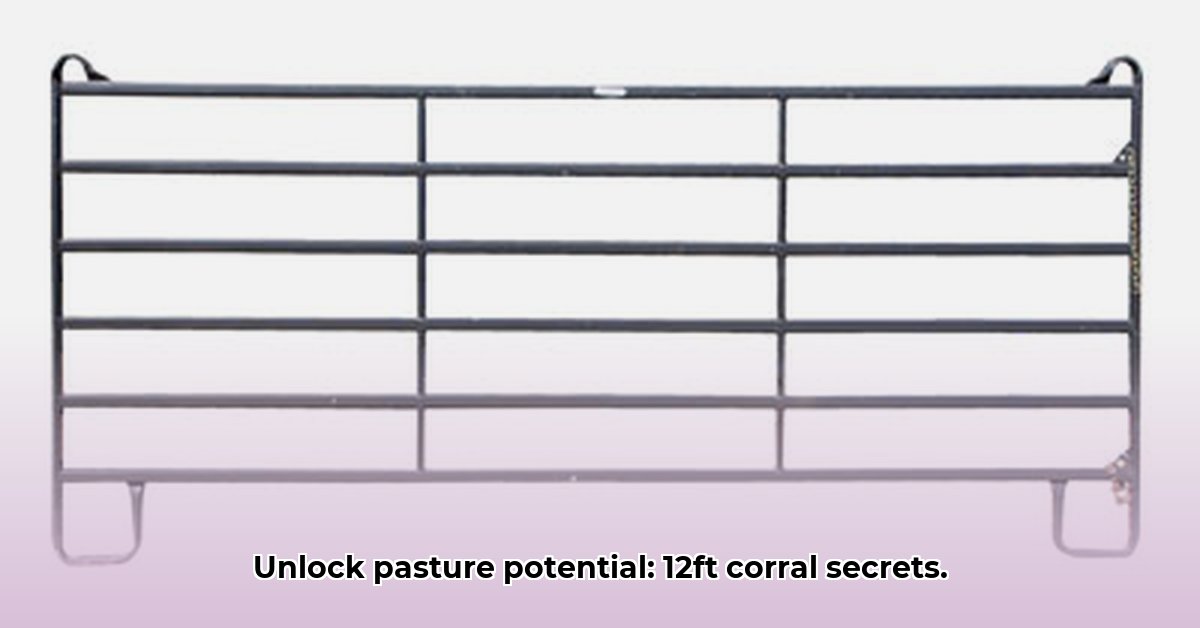
12 ft Corral Panels: Optimizing Your Pasture for Sustainable Grazing
Boosting pasture productivity is key to environmentally friendly and profitable farming. Rotational grazing is a proven method, and 12-foot corral panels from Tractor Supply are the tools to make it happen. These panels are more than just fencing; they're a cornerstone of a thriving grazing system. Don't just passively graze; actively manage your land for optimal yield. How can you ensure the most efficient use of your pasture land? For more pasture improvement resources, check out this helpful guide.
Designing Your Rotational Grazing System: A Step-by-Step Guide
Setting up a rotational grazing system with 12-foot panels requires careful planning. Here's a straightforward guide:
Mapping Your Land: Divide your pasture into smaller paddocks. Consider herd size, land shape, and the 12-foot panel length when creating manageable sections. Uneven terrain might demand creative solutions for effective division.
Strategic Panel Placement: Placement is crucial for efficiency and animal welfare. Consider water sources, access points (gates!), and shade. Easy livestock entry and exit are vital. Position panels to minimize animal stress during transitions.
Smooth Transitions with Gates: Invest in quality gates for easy paddock transitions. Smooth transitions between paddocks keep animals calm, which directly contributes to their welfare.
Electric Fencing: Enhanced Control: Electric netting or wire, used with the panels, provides superior livestock control compared to traditional fencing. Proper installation and maintenance are critical for safety and efficiency. What are the key success factors in this step?
Ongoing Maintenance: Regularly inspect panels and repair or replace damaged sections promptly to prevent escapes and maintain structural integrity. Preventative maintenance maximizes the lifespan of your investment.
The Advantages of Using 12-foot Corral Panels from Tractor Supply
These panels offer numerous benefits that contribute to both efficient farming and sustainable land management:
Flexibility and Adaptability: Easily adjust paddocks to suit your herd's needs, adapting to changing weather or conditions. This flexibility is key to adapting to various unexpected situations.
Effortless Portability: Move panels quickly and efficiently, allowing for easy paddock rotation—the core of rotational grazing. How does this ease of movement translate into improved management practice?
Long-Term Cost Savings: While there's an initial investment, durable panels offer long-term cost savings, reducing expenses over time. What are the long term cost benefits compared to alternative approaches?
Improved Pasture Quality: Rotational grazing, facilitated by these panels, ensures even grazing, allowing grass to recover, and reducing overgrazing.
Healthier Soil and Better Fertility: Resting paddocks between grazing periods improves soil structure and fertility, leading to more productive pastures. What are the quantifiable improvements in soil health that can be achieved with efficient rotational grazing?
Happier Animals: Reduced stress from rotational grazing contributes to better animal health and productivity.
How to Improve Grazing Efficiency with Electric Fencing for Sustainable Ranching
Efficient grazing is about land stewardship. Rotational grazing, using smaller paddocks, allows for strategic animal movement, giving each area time to recover, effectively preventing overgrazing. This is where 12ft corral panels excel. Their portability lets you adjust paddock sizes and locations as needed.
Setting Up Your Electric Fencing System: A Step-by-Step Guide
Here’s how to build your sustainable grazing system using 12ft corral panels:
Pasture Assessment: Identify soil types, water sources, and grass growth patterns to inform paddock design.
Determine Paddock Sizes: Consider herd size, grass growth rate, and grazing periods. Smaller paddocks are ideal for intensive rotational grazing.
Paddock Layout: Use the 12ft panels to define paddock boundaries, optimizing panel placement using existing fences or natural barriers, and considering accessibility.
Electric Fence Installation: Securely attach electric wire to panels, ensuring connections are secure and the system is properly grounded. A functioning fence is paramount.
Monitoring and Adjustments: Regularly check the fence for damages and maintain adequate power. Adjust paddock sizes and rotation schedules based on weather and growth.
The Benefits of Rotational Grazing with Electric Fencing
Improved Pasture Health: Resting pastures recovers them from overgrazing and soil compaction, resulting in healthier, more productive pastures.
Increased Livestock Productivity: Nutrient-rich forage improves animal health and weight gain.
Reduced Weed Pressure: Healthy pastures resist weed encroachment, minimizing herbicide use.
Enhanced Soil Health: Improved soil structure, water infiltration, and carbon sequestration are significant benefits.
Cost-Effective Management: Rotational grazing can reduce labor costs associated with traditional fencing and supplemental feeding.
Addressing Potential Challenges
Potential challenges include: initial investment costs, animal acclimation, and periodic fence maintenance. Careful planning and training can minimize these challenges.
Remember, sustainable grazing is a holistic approach that integrates careful planning with the right tools, like 12ft corral panels from Tractor Supply. This approach combines productive ranching with environmental responsibility. Link to Tractor Supply 12ft panels